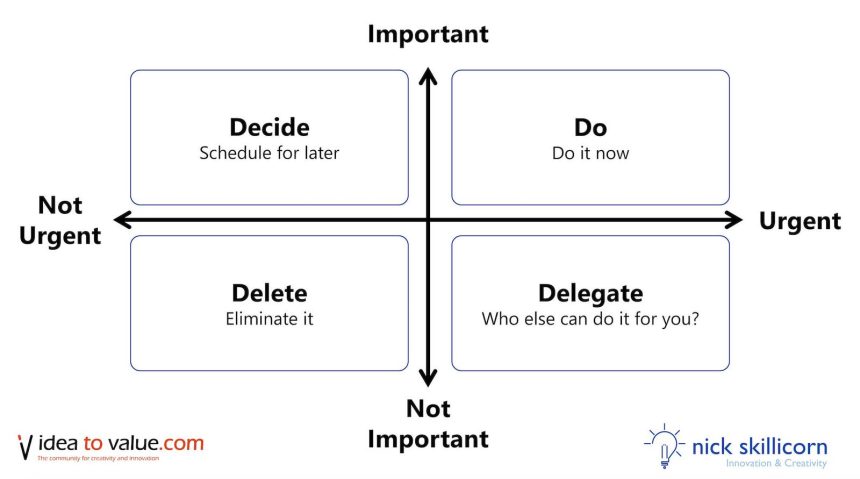In the busyness of life, it’s easy to succumb to the tyranny of our day-to-day tasks and responsibilities. Some of which certainly have to get done, like ensuring our family eats, bills are paid, and basic functions of our job so we don’t get fired. Others, however, are less critical but loud. Either they literally make noise from our phone or computer, or they have some other way of ‘screaming’ for our attention.
But the elements of a fulfilling, and successful, by many of our definitions, life are not loud in any of these ways. Intentional performance requires recognizing the power of important, if not necessarily urgent, activities, and ensuring that they get the time and attention they deserve. Investing in these generates powerful returns in three dimensions: Me, We, and World.
This approach can be particularly transformative at work, specifically, in the Job Sphere of my Spheres of Impact framework. Determining what tasks need immediate attention and what can wait is prioritization, a highly-regarded professional skill. But what really separates the most impactful individuals from the rest is the ability to recognize the things that could wait, but shouldn’t. To inform that discernment, the Eisenhower Matrix is a powerful tool to relieve pressure and improve your impact at work.
The Eisenhower Matrix is a simple two-by-two grid that offers an organized way to manage tasks based on their importance and urgency. On one axis lies importance—ranging from matters of great significance to less important. On the other axis lies urgency — how immediately we must actually do something. (Be sure you’re evaluating the real level of urgency, not someone else’s judgment of it, or a phone alert.) By categorizing tasks into these four quadrants, the matrix provides a clear roadmap for how to invest your time and energy.
- Top Right: This quadrant comprises activities that are both urgent and important. They are non-negotiables, the assignments that demand your immediate attention. Whether it’s a pressing client matter, a deadline set by your boss, or a critical business opportunity, these tasks have a direct impact on your professional success and should be prioritized accordingly.
- Top Left: It’s this second quadrant that often gets overlooked but holds immense power. Here we see activities that are important but not urgent. They are often related to long-term strategy, desired impact, and personal growth, and include activities like mentorship conversations, evaluating the sustainability of your supply chain, or planning your career trajectory. While they may not scream for attention, they are vital for your growth and the impact you make.
- Bottom Right: The third quadrant contains tasks that are urgent but lack true importance. While these may demand immediate action, it’s crucial to discern their real impact on your long-term goals. Sometimes, a conversation with stakeholders can help clarify the importance of these seemingly urgent tasks. They also might be candidates for delegating to another colleague for whom they could be important in the form of learning, exposure, or otherwise.
- Bottom Left: The fourth quadrant consists of tasks that are neither important nor urgent. These items can safely be left off your to-do list without any risk to performance or outcomes.
We sacrifice these second quadrant activities in favor of urgent, but not important, matters at our own peril. It is those weighty reflections, powerful conversations, and forward-looking planning that advance our growth toward our true potential. Embracing the important, not urgent, elements of your work can unlock profound insights that we can’t possibly have during days of back-to-back thirty-minute meetings and email management.
If you are seeking growth in your career then, find a way to dedicate specific time blocks to focus solely on these ‘second quadrant’ tasks. It’s also helpful to develop habits or rituals for this time, a running list of topics, and/or templates so you don’t feel lost or overwhelmed when those calendar blocks come along. By scheduling – and honoring – regular times for bigger picture thinking, you set yourself up for transformative growth.
Specific examples illustrate the effectiveness of this approach. As I recently prepared for my second book launch, there was a lot to do. The launch date was a loud and final deadline for publishing the website, scheduling launch events, and ordering books for clients and colleagues. However, I knew form past experience and wise advisors that it would not ensure my clarity about the impact I wanted the book to have. That required the quiet, sometimes slow, work of the creative process and deep engagement with my audience. By building in at least one calendar block of two to three hours each week for these activities, I ensured they received the attention they deserved, even if the website launched a few days late and with a round or two less of edits than I’d have liked.
Similarly, investing time in activities like watching educational videos, taking the time to reflect on the learnings and successes of the day/week/month/quarter, or nurturing professional relationships might not have immediate deadlines. But we all know, from experience and received wisdom that those are the activities that truly move the needle for long-term success. How many leaders have you heard describe the game-changing insights they have in the shower, on a run, or playing with their kids?
To apply the insights of the Eisenhower Matrix to your own life, take a moment to reflect on what truly matters in your job. Identify tasks and activities that are crucial for your growth and success but lack urgent deadlines. Make a list and allocate dedicated time for these tasks on your calendar. Start small, even with just 30 minutes a week, and gradually increase the time as you witness the positive impact it has on your work and personal fulfillment. Of course, the same approach can be taken in any of the Spheres of Impact, to make more intentional investments in your Self, Family and Friends, Community, or Money.
Remember, the key to truly satisfying success lies in not only managing the urgent, but also investing time and energy in what truly matters in the long run.
Follow me on LinkedIn for other inspiring leaders and their paths to deep impact, meaning, and purpose. Or email me to recieve a Purposeful Habits worksheet.
Read the full article here










